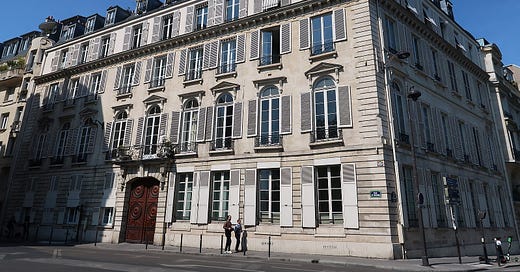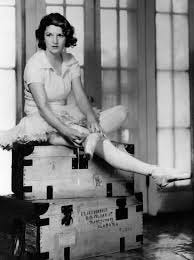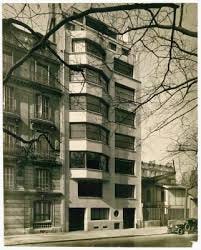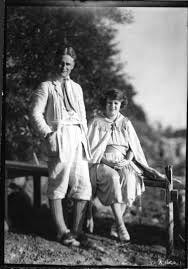Zelda Fitzgerald dressed for dance class
Somewhat belatedly, the city of Paris has decided to put a plaque on the building at 58 rue de Vaugirald where Scott and Zelda Fitzgerald spent some time in 1928. To be fair, there are few suitable sites, since the Fitzgerald always stayed in hotels and never owned any property. But their friends Gerald and Sara Murphy had leased a fourth floor apartment in this building while they waited for architect Michel Roux-Spitz to complete his art deco showpiece at nearby 14 rue Guynemer, in which they’d bought the penthouse. (Scott used it as the basis of Abe North’s home in Tender Is the Night.) As the rue de Vaugirard apartment was now empty, the Fitzgeralds moved in.
58 rue de Vaugirard (top) and 14 rue Guynemer (below)
In 1925, the Mujrphys’ daughter Honoria introduced Zelda to her dancing teacher, Lubov Egorova, former head of the Ballet Russe school, who had opened a school in Paris. Three years later, Zelda announced her ambition to revive her childhood ambition to dance.
The Fitzgeralds arrived back in Paris in April 1928. At 27, Zelda was well past the optimum age, but Egorova assured her that, while she might never dance with Diaghilev, she could hope for a career, providing she followed the strict regimen of four hours practice seven days a week. Scott volunteered to pay the $300 a month for lessons, but Zelda refused, insisting she could make the money by selling stories and articles. Dancing was to be her declaration of artistic independence. As she wrote of herself later, “Reaching her goal, she would drive the devils that had driven her. In proving herself, she would achieve peace.”
The more Zelda practiced, the more friends were convinced she would never dance professionally. “There was something dreadfully grotesque in her intensity,” wrote Sara Murphy. “One could see the muscles individually stretch and pull. Her legs looked muscular and ugly. One held one’s breath until it was over. Thank God she couldn’t see what she looked like.” Theater producers visiting the school raised Zelda’s hopes, only to crush them by admitting she interested them solely as a possible novelty dancer at the Folies-Bergère, demonstrating the current dance craze, the Shimmy.
These months were distinguished in Scott's memory by "drinking and general unpleasantness." Zelda accused him of being "literally eternally drunk the whole summer." Given her behavior, one can see why he might have taken refuge in the bottle. Indifferent to her surroundings or company, she would play the same record over and over, practicing her dance exercises, or take to the floor at a club and dance alone, skirt lifted above her waist. Scott was increasingly prone to rages. Leaving a club, he noticed a street seller offering a tray of toys and novelties. After staring at them briefly, he kicked the tray, sending the objects flying.In July and August, he was twice arrested for public intoxication, and spent the night in jail. He was bailed out by the only person he felt he could ask, the African-American club owner Ada “Bricktop” Smith.
The Fitzgeralds in happier times.
The Fitzgeralds returned to America in September, and tried to take up the threads of their American lives. In the ledger where he kept a brief account of the year, his summary began "Thirty-two years old (and sore as hell about it)," and went on "Back again in a blaze of work & liquor. Broke, and languor. Ominous. No real progress in any way & wrecked myself with dozens of people." Zelda's attacks of nervous eczema and asthma alternated with manic episodes, during one of which she piled her clothes in the bath and set them on fire. At a dinner party, she solemnly gathered up the guests' jewels and boiled them with cans of tomato soup.
They returned to Paris in the spring of 1929 and rented an apartment at 10 rue Pergolese, in the chic area around the Arc de Triomphe. Zelda tried to start dance classes again but it was too late. Perhaps sensing that this would be their last time together in Paris, they threw themsleves into socialising. "Nobody knew whose party it was," she wrote . "It had been going on for weeks. When you felt you couldn't survive another night, you went home and slept and when you got back, a new set of people had consecrated themselves to keeping it alive."
Nobody could maintain such a pace, least of all someone as fragile as Zelda. In April, her skin erupted in telltale eczema. She trembled uncontrollably, failed to recognize people, and experienced delusions. “I see odd things," she wrote. "People’s arms too long, or their faces as if they were stuffed and they look tiny and far away, or suddenly out of proportion.” After a brief spell in a treatment centre for nervous disorders at Malmaison, she discharged herself, only to relapse a few days later. On April 23, 1930. Scott committed her to the first of the clinics in which she would spend the rest of her life.
A dark time - to be celebrated with a plaque? I’m not so sure.








